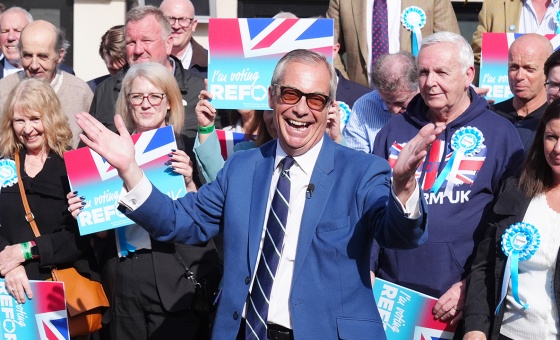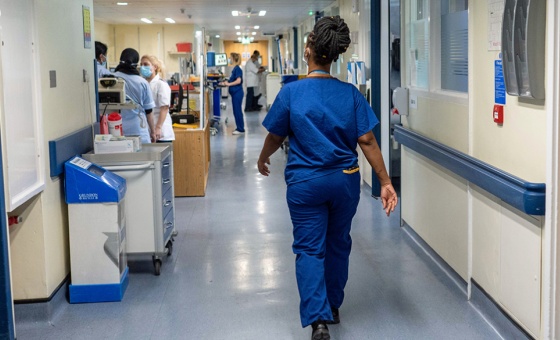This is the last article you can read this month
You can read more article this month
You can read more articles this month
Sorry your limit is up for this month
Reset on:
Please help support the Morning Star by subscribing here
In the past, interviews for top jobs were all about what school tie you wore.
Middle management positions were decided on funny handshakes and golf club membership. For rank-and-file jobs, turning up was half the battle.
But competition for jobs has got fiercer. The concept of human resources has expanded. Interview panels are more complicated, wrestling with lists of “essential qualities for candidates.”
So what happened at the interview for the new head of the NHS?
Did the panel have a piece of paper reading: “Wasted billions of health money — Desirable. Lobbied against public health care in the US — Essential.”?
Because they have appointed a man who did that and more.
The new NHS chief executive Simon Stevens has screwed up the health service on two continents.
He successfully fought off the growth of public health care in the US, killing a key component of “Obamacare.”
While in Britain he fought to get a slice of the NHS pie stuffed into the gobs of private health firms, wasting billions in the process.
Stevens was health adviser to both Labour health secretary Alan Milburn and prime minister Tony Blair. He was intimately involved in Blair’s privatisations.
He is the main author of the “NHS Plan” launched in 2000. The plan took NHS-funded operations out of NHS hospitals, handing them over to private companies.
This was a bonanza for health companies and private equity firms behind them. It built a whole industry of firms sucking up NHS cash. Paying their profits wasted NHS cash and resources.
For example, under Stevens’s plan the NHS gave up buying its own MRI scanners. It paid a private company to do the scans from the back of lorries in hospital car parks instead.
A company called Alliance Medical was paid for all the scans in the contract, even though it only did 80 per cent of the work. The Royal College of Radiologists and the NHS Clinical Guardian didn’t trust the quality of the work, so hospitals had to duplicate many of the scans anyway.
The same plan meant the NHS bought hundreds of thousands of minor operations from private clinics called “independent-sector treatment centres” (ISTCs).
Under Stevens’s plan, the NHS paid private firms like Care UK 15 per cent above the NHS rate to encourage the growth of a “market.”
It also paid firms whether the operations was done or not. Estimates by Professor Allyson Pollock, an academic critic of the scheme, suggest that up to £1.6 billion may have been wasted on phantom operations.
The NHS was stuck with training costs and “difficult” cases, while the private sector creamed off easy work and profits.
Still, Stevens’s old boss Milburn has a new job with private equity firm Bridgepoint Capital, which owned Alliance Medical and now owns Care UK — the companies profiting from the crazy scheme.
Stevens was central to one of the worst NHS financial disasters. He helped to run the 2002 Prime Minister’s Seminar on NHS Information Systems which launched Connecting for Health.
This NHS-wide computer system was supposed to create electronic patient records. It has cost between £12bn and £20bn pounds but basically doesn’t work.
Newspapers usually write the Connecting for Health story as a “wasteful Labour government in computer cock-up” tale.
But Connecting for Health was actually driven by new Labour’s determination to hand over NHS cash to private firms.
Stevens’s record of the seminar says: “The key was to use stronger central direction to accelerate the pace of change and make more use of partnerships with the private sector.”
So Stevens helped Labour centrally direct the NHS to sign partnerships with IT firms. The result was a disastrous waste of cash.
Connecting for Health was actually a double privatisation. First, it meant handing over NHS money to the IT contractors.
Second, the whole system was designed to hand over operations to the private sector.
Transferring electronic patient records was meant to make transferring NHS patients to private hospitals easier.
In 2004 Stevens left Britain to join private US health firm UnitedHealth, becoming executive vice-president at a firm winning NHS work from his NHS Plan.
There is a persistent link between Stevens and computers and funny business with money.
In 2009 UnitedHealth, the firm Stevens helped to lead, paid a $350 million court settlement.
UnitedHealth used a computer database to systematically cheat its customers.
The American Medical Association said UnitedHealth’s payments database was a “corrupt system” and “intentionally manipulated” and “rigged.”
Patients who went to see a doctor outside UnitedHealth’s business associates were deliberately given less of their UnitedHealth insurance money for medical treatments, leaving patients with bigger bills.
Stevens wasn’t satisfied with just working for a scandal-hit US health firm.
He worked to screw up the US national health system as well. In Britain Stevens tried to make the NHS more like the private health system that fails so many US citizens.
In the US President Barack Obama made tentative steps towards a European-style health system. So Stevens did all he could to obstruct Obamacare.
Obama’s scheme offers private health-care plans for most people in the US, with some government backing.
However, in 2008 he also proposed a “public option.” In the original Obamacare, a small publicly run health insurance scheme would compete with private firms like UnitedHealth.
The public option would curb private insurance profiteering. The idea of having to compete with the public option was too much for Stevens, who ran UnitedHealth’s political lobbying in the US, and he organised a pincer movement against it.
First, in 2009 UnitedHealth sent its staff to the town hall meetings where Tea Party types attacked Obama’s reforms as “socialist.”
UnitedHealth mobilised advocacy specialists, priming staff with “talking points” like: “A government-run health plan would be a roadblock to meaningful health-care reform.”
UnitedHealth staff were mobilised during working hours to attack Obama’s reforms.
While Stevens sent his staff to join the barmy right-wing town hall meetings alongside crazy Republicans, he personally lobbied right-wing Democrats — known as “Blue Dog Democrats” — to kill the public option. Stevens’s campaign won and the public option of Obamacare died.
So having introduced profiteering into the NHS, Stevens then fought to keep the government out of health care in the US.
By putting Stevens in charge of the NHS, the government has put a self-destruct mechanism in the centre of our health service.






